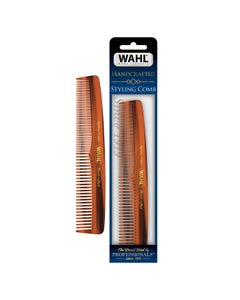

How to Do a High & Tight
What is a High & Tight?
Looking to sharpen your look? Follow along with Casey Gilbert’s step-by-step tutorial on how to do the High & Tight haircut using your Wahl clippers at home. The High & Tight haircut features a shaved back and sides, while the top is blended or faded into longer hair. It was a popular military hairstyle for men. Even more popular today – go on, make it happen. You got this!
How to Do a High & Tight Step-by-Step
1. Begin with Damp Hair
Shower up or dampen your hair with a spray bottle. Comb your hair down so it is lying straight, facing the same direction.


2. Start at the Back


Using your Wahl hair clipper, attach guard #1 (1/8") or #2 (1/4") and buzz the back of the neck and under the rim of the head. (Sections 1 and 2. See infographic above.) At this length, using upward rocking motions, start from the bottom and work your way up.
Guide Comb Math: The smaller the number of the guide comb (or guard), the shorter the cut. The larger the number, the longer the hair will be.


3. Take it to the Top
Use guard #5 (5/8") or #6 (3/4") to clip the hair on the top of the head (section 4). You can dampen your hair with a spray bottle again here if you wish.


4. Next: Blend
Blend into the rim of the head (section 3) using the #2 guard (1/4") or the #3 guard (3/8")


5. Touch up
Use the inverted clipper technique to touch up the area around the ears and the back of the neck. And you’re done – finish off your look with a fingertip-sized amount of product to keep your High & Tight looking sharp and smelling great!


6. Trim Regularly
The High & Tight haircut requires a trim every two to three weeks to stay fresh, but overall is easy to maintain.
What You'll Need
Your High & Tight Questions
What is High & Tight hair?
A dynamic and easy-to-maintain cut, like a military version of the crew cut. “High” because it features a longer strip of hair on top, sometimes faded. And “Tight” because the sides and back are shaved.
This cut was a common military cut but became more popular because of its ease and low maintenance. For the novice, a High & Tight is an easy first style to try at home with a trusty Wahl hair clipper.
What are "Sections of the Head?”
Great question. See below for details, or view our handy video and illustrations.
- Section 1: Back of the neck. (Sometimes referred to as the nape.)
- Section 2: Under the rim of the head. (Sometimes referred to as under the crown.)
- Section 3: Rim of the head. (Sometimes referred to as the crown.)
- Section 4: Top of the head.
What is a High & Tight Fade
As we mentioned above, this style is “high” or longer on top and “tight” because the sides and back are shaved. The Fade refers to how the top and sides meet – they can be blended for a softer look or faded into slightly longer hair. Both look fresh – experiment on what style best suits your fashion sense and face shape.

 India (English)
India (English)
 Middle East and Africa (English)
Middle East and Africa (English)
 South Africa (English)
South Africa (English)
 Australia (English)
Australia (English)
 Japan (日本語)
Japan (日本語)
 South East Asia (English)
South East Asia (English)
 Singapore (English)
Singapore (English)
 Europe (English)
Europe (English)
 United Kingdom (English)
United Kingdom (English)
 Argentina (Español)
Argentina (Español)
 Brazil (Portuguese)
Brazil (Portuguese)
 Colombia (Español)
Colombia (Español)
 Latin America (Español)
Latin America (Español)
 México (Español)
México (Español)
 Chile (Español)
Chile (Español)
 Peru (Español)
Peru (Español)
 Canada (English)
Canada (English)







